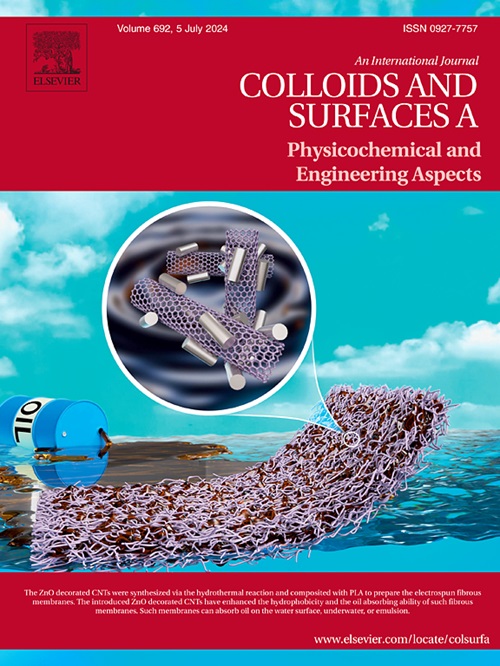由芳纶纳米纤维和生物质衍生的磁性碳纳米颗粒组成的轻质坚固气凝胶,可用于先进的微波吸收和红外隐身
IF 4.9
2区 化学
Q2 CHEMISTRY, PHYSICAL
Colloids and Surfaces A: Physicochemical and Engineering Aspects
Pub Date : 2025-07-23
DOI:10.1016/j.colsurfa.2025.137797
引用次数: 0
摘要
碳气凝胶具有超低密度、高孔隙率、连续三维导电网络等特点,在微波吸收和红外隐身应用中具有独特的优势。然而,开发具有优异机械稳健性以满足实际应用需求的碳气凝胶仍然是一个重大挑战。本文成功构建了一种轻质且坚固的气凝胶,该气凝胶由生物质衍生的磁性镍/碳(Ni/C)纳米颗粒和芳纶纳米纤维(ANF)组装而成。采用创新的湿喷涂技术合成磁性Ni/C纳米颗粒,充分利用生物质海藻酸钠对金属镍离子的强螯合能力。该工艺经高温碳化后,可制得具有高比表面积的磁性Ni/C纳米颗粒,具有工艺简单、收率高的优点。同时,ANF通过可伸缩的自上而下去质子化方法制造,作为支撑骨架,确保结构完整性和机械稳健性。优化后的气凝胶具有独特的层状网络结构,其超低密度为0.0168 g/cm3,在40 %应变下循环100次后,弹性回复率超过95 %。因此,优化后的气凝胶具有出色的电磁微波吸收(EMA)性能,在14.87 GHz时,最小反射损耗(RLmin)为- 49.497 dB,在2.0 mm厚度时,有效吸收带宽(EAB)为5.41 GHz。同时,优化后的气凝胶具有良好的红外隐身性能。在80℃的加热台上辐照60 min后,优化后的气凝胶表面温度仅从25.3℃上升到26.9℃。该研究为设计具有平衡力学性能和多功能性能的气凝胶材料提供了一种策略范式。本文章由计算机程序翻译,如有差异,请以英文原文为准。
Lightweight and robust aerogel assembling with aramid nanofibers and biomass-derived magnetic carbon nanoparticles toward advanced microwave absorption and infrared stealth
Carbon aerogel exhibits unique advantages in microwave absorption and infrared stealth applications owing to its ultralow density, high porosity, and continuous three-dimensional conductive networks. Nevertheless, developing carbon aerogel with excellent mechanical robustness to meet the practical application demands remains a significant challenge. Herein, a lightweight and robust aerogel assembling with biomass-derived magnetic nickel/carbon (Ni/C) nanoparticles and aramid nanofibers (ANF) is successfully constructed. The magnetic Ni/C nanoparticles are synthesized via an innovative wet-spraying technique that fully exploits the strong chelation capability of biomass sodium alginate toward metallic nickel ions. After high-temperature carbonization, this process yields magnetic Ni/C nanoparticles with high specific surface area, and offers advantages of simple processing procedures and high yield. Concurrently, the ANF is fabricated by a scalable top-down deprotonation approach, acting as a supportive skeleton to ensure structural integrity and mechanical robustness. The optimized aerogel delivers a unique lamellar network architecture with an ultra-low density of 0.0168 g/cm3 and outstanding elastic recovery exceeding 95 % after 100 cycles at 40 % strain. Consequently, the optimized aerogel delivers remarkable electromagnetic microwave absorption (EMA) performance, achieving a minimum reflection loss (RLmin) of −49.497 dB at 14.87 GHz, and an effective absorption bandwidth (EAB) of 5.41 GHz at a thickness of 2.0 mm. Simultaneously, the optimized aerogel exhibits excellent infrared (IR) stealth capability. After being exposed to IR radiation for 60 min on a heating platform at 80 ℃, the surface temperature of the optimized aerogel only rise from 25.3 ℃ to 26.9 ℃. This study provides a strategic paradigm for designing aerogel material with balanced mechanical properties and multi-functional performance.
求助全文
通过发布文献求助,成功后即可免费获取论文全文。
去求助
来源期刊
CiteScore
8.70
自引率
9.60%
发文量
2421
审稿时长
56 days
期刊介绍:
Colloids and Surfaces A: Physicochemical and Engineering Aspects is an international journal devoted to the science underlying applications of colloids and interfacial phenomena.
The journal aims at publishing high quality research papers featuring new materials or new insights into the role of colloid and interface science in (for example) food, energy, minerals processing, pharmaceuticals or the environment.

 求助内容:
求助内容: 应助结果提醒方式:
应助结果提醒方式:


